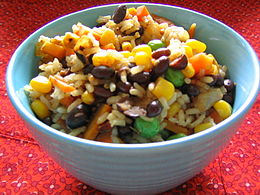 There has been a lot of concern with the rising incidence of type 2 diabetes in the US and other countries. Along with that is an interest in blood glucose levels after meals (postprandial blood glucose response or PBGR). Glucose is a type of sugar that slightly rises after a meal, and some types of foods rise it more than others. It is thought that big spikes in glucose levels in the blood are unhealthy for both long-term health and also if one has diabetes. A nicely done Canadian study (people randomly assigned to groups) found that swapping out half of a portion of starchy potatoes or rice with lentils reduced levels of blood glucose levels by 20% (when replacing rice) to 35 % (replacing potatoes).
There has been a lot of concern with the rising incidence of type 2 diabetes in the US and other countries. Along with that is an interest in blood glucose levels after meals (postprandial blood glucose response or PBGR). Glucose is a type of sugar that slightly rises after a meal, and some types of foods rise it more than others. It is thought that big spikes in glucose levels in the blood are unhealthy for both long-term health and also if one has diabetes. A nicely done Canadian study (people randomly assigned to groups) found that swapping out half of a portion of starchy potatoes or rice with lentils reduced levels of blood glucose levels by 20% (when replacing rice) to 35 % (replacing potatoes).
What foods are pulses? Pulses are dried seeds of legume plants, and include all lentils, dry beans, and dry peas. This includes, baked beans, all lentils (red, green, yellow, brown), chickpeas (garbanzo beans), black-eyed peas, runner beans, fava beans, kidney beans, lima beans, haricots, cannellini beans, pinto beans, etc. They provide fiber in the diet and are a great source of protein. From Science Daily: Lentils significantly reduce blood glucose levels
Replacing potatoes or rice with pulses can lower your blood glucose levels by more than 20 per cent, according to a first-ever University of Guelph study. Prof. Alison Duncan, Department of Human Health and Nutritional Sciences, and Dan Ramdath of Agriculture and Agri-Food Canada, found that swapping out half of a portion of these starchy side dishes for lentils can significantly improve your body's response to the carbohydrates.
Replacing half a serving of rice with lentils caused blood glucose to drop by up to 20 per cent. Replacing potatoes with lentils led to a 35-per-cent drop. "Pulses are extremely nutrient-dense food that have the potential to reduce chronic diseases associated with mismanaged glucose levels," said Duncan, who worked on the study with PhD student Dita Moravek and M.Sc. students Erica Rogers, Sarah Turkstra and Jessica Wilson.
Published and specially featured in the Journal of Nutrition, the study involved 24 healthy adults fed four dishes -- white rice only, half white rice and half large green lentils, half white rice and half small green lentils, and half white rice and half split red lentils. Researchers measured glucose levels in the participants' blood before they ate and during two hours afterward. They repeated the process for white potatoes alone and the same combinations of potatoes and lentils. "We mixed the lentils in with the potatoes and rice because people don't typically eat pulses on their own, but rather consume them in combination with other starches as part of a larger meal, so we wanted the results to reflect that."
Blood glucose fell by similar amounts when half of the starch was replaced with each of the three types of lentils. Blood glucose comprises sugar found in the blood during digestion in the upper digestive tract and depends on the starch content of foods consumed.
Pulses, such as lentils, can slow digestion and the release of sugars found in starch into the bloodstream, ultimately reducing blood glucose levels, said Duncan. "This slower absorption means you don't experience a spike in glucose. Having high levels over a period of time can lead to mismanagement of blood glucose, which is the hallmark of Type 2 diabetes. Essentially, eating lentils can lower that risk."
Pulses contain components that inhibit enzymes involved in absorption of glucose, and fibre contained in these foods can encourage the production of short-chain fatty acids, which can also help to reduce blood glucose levels, added Duncan.
